Layout Customizations in MAUI Popup (SfPopup)
17 Apr 202324 minutes to read
Popup appearance mode for footer
The SfPopup supports two types of AppearanceMode. By default, the OneButton is set. Change the appearance by using the AppearanceMode property.
The two different appearance modes in the SfPopup are as follows:
| Modes | Description |
|---|---|
Shows the SfPopup with one button (accept button) in the footer view. This is the default value. |
|
Shows the SfPopup with two buttons (accept & decline buttons) in the footer view. |
In the following code example, set the AppearanceMode property as OneButton, which displays only the Accept button in the footer view.
<ContentPage xmlns="http://schemas.microsoft.com/dotnet/2021/maui"
xmlns:x="http://schemas.microsoft.com/winfx/2009/xaml"
xmlns:sfPopup="clr-namespace:Syncfusion.Maui.Popup;assembly=Syncfusion.Maui.Popup"
x:Class="PopupMauiLayout.MainPage">
<ContentPage.Content>
<StackLayout Padding="20">
<Button x:Name="clickToShowPopup" Text="ClickToShowPopup"
VerticalOptions="Start" HorizontalOptions="Center"
Clicked="ClickToShowPopup_Clicked" />
<sfPopup:SfPopup x:Name="sfPopup"
AppearanceMode="OneButton"
ShowFooter="True">
</sfPopup:SfPopup>
</StackLayout>
</ContentPage.Content>
</ContentPage>using Syncfusion.Maui.Popup;
public partial class MainPage : ContentPage
{
public MainPage()
{
InitializeComponent();
sfPopup.ShowFooter = true;
// Setting the AppearanceMode as OneButton
sfPopup.AppearanceMode = PopupButtonAppearanceMode.OneButton;
}
private void ClickToShowPopup_Clicked(object sender, EventArgs e)
{
sfPopup.Show();
}
}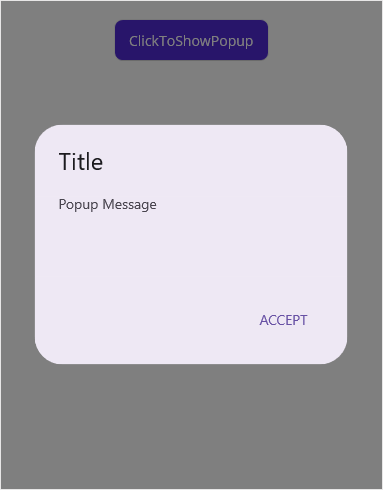
In the following code example, set the AppearanceMode property as TwoButton, which displays both Accept and Decline buttons in the footer view.
<ContentPage xmlns="http://schemas.microsoft.com/dotnet/2021/maui"
xmlns:x="http://schemas.microsoft.com/winfx/2009/xaml"
xmlns:sfPopup="clr-namespace:Syncfusion.Maui.Popup;assembly=Syncfusion.Maui.Popup"
x:Class="PopupMauiLayout.MainPage">
<ContentPage.Content>
<StackLayout Padding="20">
<Button x:Name="clickToShowPopup" Text="ClickToShowPopup"
VerticalOptions="Start" HorizontalOptions="Center"
Clicked="ClickToShowPopup_Clicked" />
<sfPopup:SfPopup x:Name="sfPopup"
AppearanceMode="TwoButton"
ShowFooter="True">
</sfPopup:SfPopup>
</StackLayout>
</ContentPage.Content>
</ContentPage>using Syncfusion.Maui.Popup;
public partial class MainPage : ContentPage
{
public MainPage()
{
InitializeComponent();
sfPopup.ShowFooter = true;
// Setting the AppearanceMode as TwoButton
sfPopup.AppearanceMode = PopupButtonAppearanceMode.TwoButton;
}
private void ClickToShowPopup_Clicked(object sender, EventArgs e)
{
sfPopup.Show();
}
}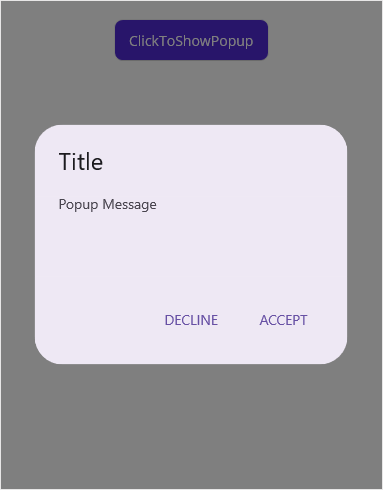
Popup region customization
Disable header
Display the Popup without a header by using the property ShowHeader. The default value is true. Find the code example of the same as follows.
<ContentPage xmlns="http://schemas.microsoft.com/dotnet/2021/maui"
xmlns:x="http://schemas.microsoft.com/winfx/2009/xaml"
xmlns:sfPopup="clr-namespace:Syncfusion.Maui.Popup;assembly=Syncfusion.Maui.Popup"
x:Class="PopupMauiLayout.MainPage">
<ContentPage.Content>
<StackLayout Padding="20">
<Button x:Name="clickToShowPopup" Text="ClickToShowPopup"
VerticalOptions="Start" HorizontalOptions="Center"
Clicked="ClickToShowPopup_Clicked" />
<sfPopup:SfPopup x:Name="sfPopup"
ShowHeader="False"
ShowFooter="True">
</sfPopup:SfPopup>
</StackLayout>
</ContentPage.Content>
</ContentPage>using Syncfusion.Maui.Popup;
public partial class MainPage : ContentPage
{
public MainPage()
{
InitializeComponent();
sfPopup.ShowHeader = false;
sfPopup.ShowFooter = true;
}
private void ClickToShowPopup_Clicked(object sender, EventArgs e)
{
sfPopup.Show();
}
}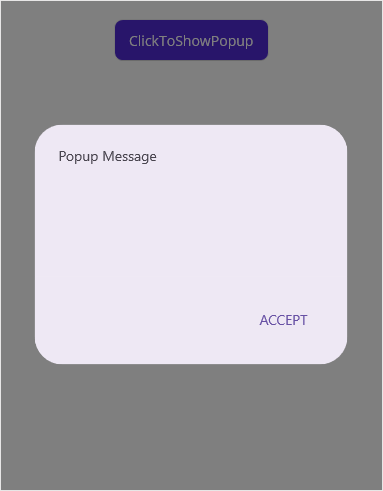
Enable footer
Display the Popup with the footer by using the ShowFooter property. The default value is false. Find the code example of the same as follows.
<ContentPage xmlns="http://schemas.microsoft.com/dotnet/2021/maui"
xmlns:x="http://schemas.microsoft.com/winfx/2009/xaml"
xmlns:sfPopup="clr-namespace:Syncfusion.Maui.Popup;assembly=Syncfusion.Maui.Popup"
x:Class="PopupMauiLayout.MainPage">
<ContentPage.Content>
<StackLayout Padding="20">
<Button x:Name="clickToShowPopup" Text="ClickToShowPopup"
VerticalOptions="Start" HorizontalOptions="Center"
Clicked="ClickToShowPopup_Clicked" />
<sfPopup:SfPopup x:Name="sfPopup"
ShowFooter="True">
</sfPopup:SfPopup>
</StackLayout>
</ContentPage.Content>
</ContentPage>using Syncfusion.Maui.Popup;
public partial class MainPage : ContentPage
{
public MainPage()
{
InitializeComponent();
sfPopup.ShowFooter = true;
}
private void ClickToShowPopup_Clicked(object sender, EventArgs e)
{
sfPopup.Show();
}
}
Enable close icon
Show the Popup with a close icon by using the ShowCloseButton property. The default value is false. Find the code example of the same as follows.
<ContentPage xmlns="http://schemas.microsoft.com/dotnet/2021/maui"
xmlns:x="http://schemas.microsoft.com/winfx/2009/xaml"
xmlns:sfPopup="clr-namespace:Syncfusion.Maui.Popup;assembly=Syncfusion.Maui.Popup"
x:Class="PopupMauiLayout.MainPage">
<ContentPage.Content>
<StackLayout Padding="20">
<Button x:Name="clickToShowPopup" Text="ClickToShowPopup"
VerticalOptions="Start" HorizontalOptions="Center"
Clicked="ClickToShowPopup_Clicked" />
<sfPopup:SfPopup x:Name="sfPopup"
ShowCloseButton="True">
</sfPopup:SfPopup>
</StackLayout>
</ContentPage.Content>
</ContentPage>using Syncfusion.Maui.Popup;
public partial class MainPage : ContentPage
{
public MainPage()
{
InitializeComponent();
sfPopup.ShowCloseButton = true;
}
private void ClickToShowPopup_Clicked(object sender, EventArgs e)
{
sfPopup.Show();
}
}![]()
Customizing popup header
Any view can be added as the header content using the HeaderTemplate property. Refer to the following code example in which a label is added as a header content.
<ContentPage xmlns="http://schemas.microsoft.com/dotnet/2021/maui"
xmlns:x="http://schemas.microsoft.com/winfx/2009/xaml"
xmlns:sfPopup="clr-namespace:Syncfusion.Maui.Popup;assembly=Syncfusion.Maui.Popup"
x:Class="PopupMauiLayout.MainPage">
<ContentPage.Content>
<StackLayout Padding="20">
<Button x:Name="clickToShowPopup" Text="ClickToShowPopup"
VerticalOptions="Start" HorizontalOptions="Center"
Clicked="ClickToShowPopup_Clicked" />
<sfPopup:SfPopup x:Name="sfPopup">
<sfPopup:SfPopup.HeaderTemplate>
<DataTemplate>
<Label Text="Customized Header"
FontAttributes="Bold"
BackgroundColor="#6750A4"
FontSize="16"
HorizontalTextAlignment="Center"
VerticalTextAlignment="Center"/>
</DataTemplate>
</sfPopup:SfPopup.HeaderTemplate>
</sfPopup:SfPopup>
</StackLayout>
</ContentPage.Content>
</ContentPage>using Syncfusion.Maui.Popup;
public partial class MainPage : ContentPage
{
DataTemplate headerTemplateView;
Label headerContent;
public MainPage()
{
InitializeComponent();
clickToShowPopup.Clicked += ClickToShowPopup_Clicked;
headerTemplateView = new DataTemplate(() =>
{
headerContent = new Label();
headerContent.Text = "Customized Header";
headerContent.FontAttributes = FontAttributes.Bold;
headerContent.BackgroundColor = Color.FromArgb("#6750A4");
headerContent.FontSize = 16;
headerContent.HorizontalTextAlignment = TextAlignment.Center;
headerContent.VerticalTextAlignment = TextAlignment.Center;
return headerContent;
});
// Adding HeaderTemplate of the SfPopup
sfPopup.HeaderTemplate = headerTemplateView;
}
private void ClickToShowPopup_Clicked(object sender, EventArgs e)
{
sfPopup.Show();
}
}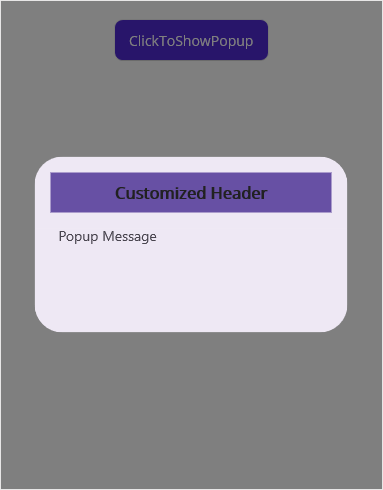
Popup header height
Customize the popup header height using HeaderHeight property. Find the code example of the same as follows.
<ContentPage xmlns="http://schemas.microsoft.com/dotnet/2021/maui"
xmlns:x="http://schemas.microsoft.com/winfx/2009/xaml"
xmlns:sfPopup="clr-namespace:Syncfusion.Maui.Popup;assembly=Syncfusion.Maui.Popup"
x:Class="PopupMauiLayout.MainPage">
<ContentPage.Content>
<StackLayout Padding="20">
<Button x:Name="clickToShowPopup" Text="ClickToShowPopup"
VerticalOptions="Start" HorizontalOptions="Center"
Clicked="ClickToShowPopup_Clicked" />
<sfPopup:SfPopup x:Name="sfPopup"
HeaderHeight="150">
</sfPopup:SfPopup>
</StackLayout>
</ContentPage.Content>
</ContentPage>using Syncfusion.Maui.Popup;
public partial class MainPage : ContentPage
{
public MainPage()
{
InitializeComponent();
sfPopup.HeaderHeight = 150;
}
private void ClickToShowPopup_Clicked(object sender, EventArgs e)
{
sfPopup.Show();
}
}Popup header title
Change the popup header title using HeaderTitle property. Find the code example of the same as follows.
<ContentPage xmlns="http://schemas.microsoft.com/dotnet/2021/maui"
xmlns:x="http://schemas.microsoft.com/winfx/2009/xaml"
xmlns:sfPopup="clr-namespace:Syncfusion.Maui.Popup;assembly=Syncfusion.Maui.Popup"
x:Class="PopupMauiLayout.MainPage">
<ContentPage.Content>
<StackLayout Padding="20">
<Button x:Name="clickToShowPopup" Text="ClickToShowPopup"
VerticalOptions="Start" HorizontalOptions="Center"
Clicked="ClickToShowPopup_Clicked" />
<sfPopup:SfPopup x:Name="sfPopup"
HeaderTitle="Header Title">
</sfPopup:SfPopup>
</StackLayout>
</ContentPage.Content>
</ContentPage>using Syncfusion.Maui.Popup;
public partial class MainPage : ContentPage
{
public MainPage()
{
InitializeComponent();
sfPopup.HeaderTitle = "Header Title";
}
private void ClickToShowPopup_Clicked(object sender, EventArgs e)
{
sfPopup.Show();
}
}Customizing popup footer
Any view can be added as the footer content using the FooterTemplate property. Refer to the following code example in which a label is added as a footer content.
<ContentPage xmlns="http://schemas.microsoft.com/dotnet/2021/maui"
xmlns:x="http://schemas.microsoft.com/winfx/2009/xaml"
xmlns:sfPopup="clr-namespace:Syncfusion.Maui.Popup;assembly=Syncfusion.Maui.Popup"
x:Class="PopupMauiLayout.MainPage">
<ContentPage.Content>
<StackLayout Padding="20">
<Button x:Name="clickToShowPopup" Text="ClickToShowPopup"
VerticalOptions="Start" HorizontalOptions="Center"
Clicked="ClickToShowPopup_Clicked" />
<sfPopup:SfPopup x:Name="sfPopup" ShowFooter="True">
<sfPopup:SfPopup.FooterTemplate>
<DataTemplate>
<Label Text="Customized Footer"
FontAttributes="Bold"
BackgroundColor="#6750A4"
FontSize="16"
HorizontalTextAlignment="Center"
VerticalTextAlignment="Center"/>
</DataTemplate>
</sfPopup:SfPopup.FooterTemplate>
</sfPopup:SfPopup>
</StackLayout>
</ContentPage.Content>
</ContentPage>using Syncfusion.Maui.Popup;
public partial class MainPage : ContentPage
{
DataTemplate footerTemplateView;
Label footerContent;
public MainPage()
{
InitializeComponent();
clickToShowPopup.Clicked += ClickToShowPopup_Clicked;
sfPopup.ShowFooter = true;
footerTemplateView = new DataTemplate(() =>
{
footerContent = new Label();
footerContent.Text = "Customized Footer";
footerContent.FontAttributes = FontAttributes.Bold;
footerContent.BackgroundColor = Color.FromArgb("#6750A4");
footerContent.FontSize = 16;
footerContent.HorizontalTextAlignment = TextAlignment.Center;
footerContent.VerticalTextAlignment = TextAlignment.Center;
return footerContent;
});
// Adding FooterTemplate of the SfPopup
sfPopup.FooterTemplate = footerTemplateView;
}
private void ClickToShowPopup_Clicked(object sender, EventArgs e)
{
sfPopup.Show();
}
}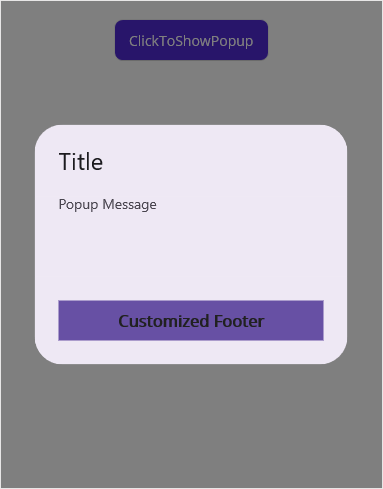
Popup footer height
Customize the popup footer height using FooterHeight property. Find the code example of the same as follows.
<ContentPage xmlns="http://schemas.microsoft.com/dotnet/2021/maui"
xmlns:x="http://schemas.microsoft.com/winfx/2009/xaml"
xmlns:sfPopup="clr-namespace:Syncfusion.Maui.Popup;assembly=Syncfusion.Maui.Popup"
x:Class="PopupMauiLayout.MainPage">
<ContentPage.Content>
<StackLayout Padding="20">
<Button x:Name="clickToShowPopup" Text="ClickToShowPopup"
VerticalOptions="Start" HorizontalOptions="Center"
Clicked="ClickToShowPopup_Clicked" />
<sfPopup:SfPopup x:Name="sfPopup" ShowFooter="True"
FooterHeight="150">
</sfPopup:SfPopup>
</StackLayout>
</ContentPage.Content>
</ContentPage>using Syncfusion.Maui.Popup;
public partial class MainPage : ContentPage
{
public MainPage()
{
InitializeComponent();
sfPopup.ShowFooter = true;
sfPopup.FooterHeight = 150;
}
private void ClickToShowPopup_Clicked(object sender, EventArgs e)
{
sfPopup.Show();
}
}Popup accept and decline buttons text
Change the popup accept and decline buttons text using AcceptButtonText and DeclineButtonText properties. Find the code example of the same as follows.
<ContentPage xmlns="http://schemas.microsoft.com/dotnet/2021/maui"
xmlns:x="http://schemas.microsoft.com/winfx/2009/xaml"
xmlns:sfPopup="clr-namespace:Syncfusion.Maui.Popup;assembly=Syncfusion.Maui.Popup"
x:Class="PopupMauiLayout.MainPage">
<ContentPage.Content>
<StackLayout Padding="20">
<Button x:Name="clickToShowPopup" Text="ClickToShowPopup"
VerticalOptions="Start" HorizontalOptions="Center"
Clicked="ClickToShowPopup_Clicked" />
<sfPopup:SfPopup x:Name="sfPopup" ShowFooter="True" AppearanceMode="TwoButton"
AcceptButtonText="Accept Button Text" DeclineButtonText="Decline Button Text">
</sfPopup:SfPopup>
</StackLayout>
</ContentPage.Content>
</ContentPage>using Syncfusion.Maui.Popup;
public partial class MainPage : ContentPage
{
public MainPage()
{
InitializeComponent();
sfPopup.ShowFooter = true;
sfPopup.AppearanceMode = PopupButtonAppearanceMode.TwoButton;
sfPopup.AcceptButtonText = "Accept Button Text";
sfPopup.DeclineButtonText = "Decline Button Text";
}
private void ClickToShowPopup_Clicked(object sender, EventArgs e)
{
sfPopup.Show();
}
}Customizing popup content
Any view can be added as popup content by using the ContentTemplate property. Refer to the following code example in which a label is added as a popup content.
<ContentPage xmlns="http://schemas.microsoft.com/dotnet/2021/maui"
xmlns:x="http://schemas.microsoft.com/winfx/2009/xaml"
xmlns:sfPopup="clr-namespace:Syncfusion.Maui.Popup;assembly=Syncfusion.Maui.Popup"
x:Class="PopupMauiLayout.MainPage">
<ContentPage.Content>
<StackLayout Padding="20">
<Button x:Name="clickToShowPopup" Text="ClickToShowPopup"
VerticalOptions="Start" HorizontalOptions="Center"
Clicked="ClickToShowPopup_Clicked" />
<sfPopup:SfPopup x:Name="sfPopup" ShowFooter="True">
<sfPopup:SfPopup.ContentTemplate>
<DataTemplate>
<Label Text="This is the customized view for SfPopup"
VerticalTextAlignment="Center" BackgroundColor="SkyBlue"
HorizontalTextAlignment="Center" Padding="10"/>
</DataTemplate>
</sfPopup:SfPopup.ContentTemplate>
</sfPopup:SfPopup>
</StackLayout>
</ContentPage.Content>
</ContentPage>using Syncfusion.Maui.Popup;
public partial class MainPage : ContentPage
{
DataTemplate contentTemplateView;
Label popupContent;
public MainPage()
{
InitializeComponent();
clickToShowPopup.Clicked += ClickToShowPopup_Clicked;
sfPopup.ShowFooter = true;
contentTemplateView = new DataTemplate(() =>
{
popupContent = new Label();
popupContent.Text = "This is the customized view for SfPopup";
popupContent.BackgroundColor = Colors.SkyBlue;
popupContent.HorizontalTextAlignment = TextAlignment.Center;
popupContent.VerticalTextAlignment = TextAlignment.Center;
popupContent.Padding = 10;
return popupContent;
});
// Adding ContentTemplate of the SfPopup
sfPopup.ContentTemplate = contentTemplateView;
}
private void ClickToShowPopup_Clicked(object sender, EventArgs e)
{
sfPopup.Show();
}
}
Popup message
Change the popup content message using Message property. Find the code example of the same as follows.
<ContentPage xmlns="http://schemas.microsoft.com/dotnet/2021/maui"
xmlns:x="http://schemas.microsoft.com/winfx/2009/xaml"
xmlns:sfPopup="clr-namespace:Syncfusion.Maui.Popup;assembly=Syncfusion.Maui.Popup"
x:Class="PopupMauiLayout.MainPage">
<ContentPage.Content>
<StackLayout Padding="20">
<Button x:Name="clickToShowPopup" Text="ClickToShowPopup"
VerticalOptions="Start" HorizontalOptions="Center"
Clicked="ClickToShowPopup_Clicked" />
<sfPopup:SfPopup x:Name="sfPopup"
Message="Popup Message">
</sfPopup:SfPopup>
</StackLayout>
</ContentPage.Content>
</ContentPage>using Syncfusion.Maui.Popup;
public partial class MainPage : ContentPage
{
public MainPage()
{
InitializeComponent();
sfPopup.Message = "Popup Message";
}
private void ClickToShowPopup_Clicked(object sender, EventArgs e)
{
sfPopup.Show();
}
}How to
Disable the overlay background in .NET MAUI Popup?
Disable the overlay background by using the SfPopup.ShowOverlayAlways property as False. The default value of the SfPopup.ShowOverlayAlways is True.
<sfPopup:SfPopup x:Name="popup"
ShowOverlayAlways="False"
IsOpen="True">
</sfPopup:SfPopup>using Syncfusion.Maui.Popup;
public partial class MainPage : ContentPage
{
SfPopup popup;
public MainPage()
{
InitializeComponent();
popup = new SfPopup();
popup.ShowOverlayAlways = false;
popup.Show();
}
}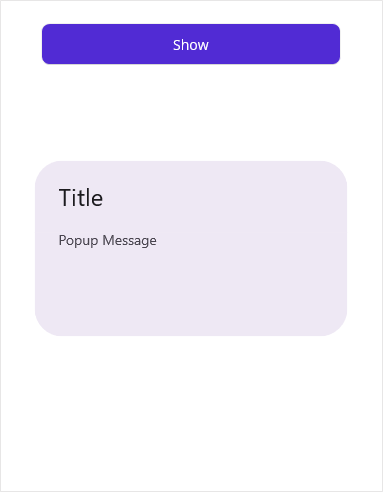
Show listView as a popup
The SfPopup allows loading the SfListView as the content of the popup.
<ContentPage xmlns="http://schemas.microsoft.com/dotnet/2021/maui"
xmlns:x="http://schemas.microsoft.com/winfx/2009/xaml"
xmlns:sfListView="clr-namespace:Syncfusion.Maui.ListView;assembly=Syncfusion.Maui.ListView"
xmlns:sfPopup="clr-namespace:Syncfusion.Maui.Popup;assembly=Syncfusion.Maui.Popup"
xmlns:local="clr-namespace:PopupMauiLayout"
x:Class="PopupMauiLayout.MainPage">
<ContentPage.BindingContext>
<local:ContactsViewModel x:Name="viewModel"/>
</ContentPage.BindingContext>
<ContentPage.Content>
<StackLayout Padding="20">
<Button Text="Click to show popup"
Clicked="OpenButton_Clicked"
HorizontalOptions="Center"/>
<sfPopup:SfPopup x:Name="sfPopup"
HeaderTitle="ListView"
ShowFooter="True"
HeightRequest="300" WidthRequest="300">
<sfPopup:SfPopup.ContentTemplate>
<DataTemplate>
<sfListView:SfListView x:Name="listView" ItemSize="46"
ItemsSource="{Binding Items}">
<sfListView:SfListView.ItemTemplate>
<DataTemplate>
<Grid x:Name="grid">
<Grid.ColumnDefinitions>
<ColumnDefinition Width="46" />
<ColumnDefinition Width="*" />
<ColumnDefinition Width="*" />
</Grid.ColumnDefinitions>
<Image Source="{Binding ContactImage}"
VerticalOptions="Center"
HorizontalOptions="Center"
HeightRequest="30"
WidthRequest="30"/>
<Label Grid.Column="1"
VerticalTextAlignment="Center"
LineBreakMode="NoWrap"
Text="{Binding ContactName}"
FontSize="14" FontFamily="Roboto"/>
<Image Grid.Column="2"
Source="{Binding ContactType}"
VerticalOptions="Center"
HorizontalOptions="End"
HeightRequest="15"
WidthRequest="15" Margin="0,0,8,0"/>
</Grid>
</DataTemplate>
</sfListView:SfListView.ItemTemplate>
</sfListView:SfListView>
</DataTemplate>
</sfPopup:SfPopup.ContentTemplate>
</sfPopup:SfPopup>
</StackLayout>
</ContentPage.Content>
</ContentPage>namespace PopupMauiPositioning;
using Syncfusion.Maui.ListView;
using Syncfusion.Maui.Popup;
public partial class MainPage : ContentPage
{
SfListView listView;
ContactsViewModel viewModel;
SfPopup sfPopup;
public MainPage()
{
InitializeComponent();
listView = new SfListView();
listView.ItemTemplate = new DataTemplate(() =>
{
var grid = new Grid();
grid.ColumnDefinitions.Add(new ColumnDefinition() { Width = 46 });
grid.ColumnDefinitions.Add(new ColumnDefinition() { Width = GridLength.Star });
grid.ColumnDefinitions.Add(new ColumnDefinition() { Width = GridLength.Star });
var contactImage = new Image()
{
VerticalOptions = LayoutOptions.Center,
HorizontalOptions = LayoutOptions.Center,
HeightRequest = 30,
WidthRequest = 30
};
contactImage.SetBinding(Image.SourceProperty, new Binding("ContactImage"));
var contactName = new Label()
{
VerticalTextAlignment = TextAlignment.Center,
LineBreakMode = LineBreakMode.NoWrap,
FontSize = 14
};
contactName.SetBinding(Label.TextProperty, new Binding("ContactName"));
var contactType = new Image()
{
VerticalOptions = LayoutOptions.Center,
HorizontalOptions = LayoutOptions.End,
HeightRequest = 15,
WidthRequest = 15,
Margin = new Thickness(0, 0, 8, 0)
};
contactType.SetBinding(Image.SourceProperty, new Binding("ContactType"));
grid.Children.Add(contactImage);
Grid.SetColumn(contactImage, 0);
Grid.SetRow(contactImage, 0);
grid.Children.Add(contactName);
Grid.SetColumn(contactName, 1);
Grid.SetRow(contactName, 0);
grid.Children.Add(contactType);
Grid.SetColumn(contactType, 2);
Grid.SetRow(contactType, 0);
return grid;
});
viewModel = new ContactsViewModel();
listView.ItemsSource = viewModel.Items;
listView.ItemSize = 46;
sfPopup = new SfPopup();
sfPopup.HeaderTitle = "ListView";
sfPopup.ShowFooter = true;
sfPopup.HeightRequest = 300;
sfPopup.WidthRequest = 300;
sfPopup.ContentTemplate = new DataTemplate(() =>
{
return listView;
});
StackLayout stackLayout = new StackLayout() { Padding = 20};
Button OpenButton = new Button();
OpenButton.HorizontalOptions = LayoutOptions.Center;
OpenButton.Clicked += OpenButton_Clicked;
OpenButton.Text = "Click to show popup";
stackLayout.Children.Add(OpenButton);
this.Content = stackLayout;
}
}private void OpenButton_Clicked(object sender, EventArgs e)
{
sfPopup.Show();
}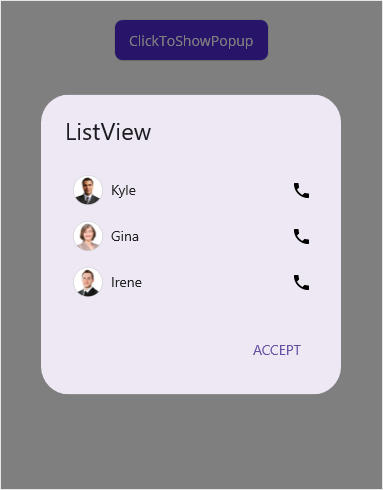
Download the entire source code from GitHub here.